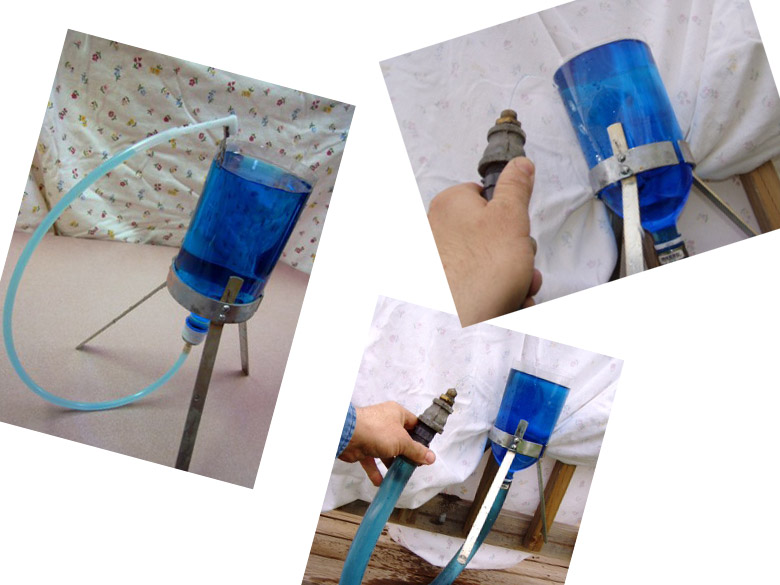When you’ve been bitten with the ‘free energy’ bug, everywhere you go you look for ideas that may contribute to the obsession. I’ve definitely been bitten.
I came across one of my ideas while out watering the garden. Water was running out of the hose. And as everyone knows, you can get the water to shoot out further by holding your thumb over the end of the hose. Hmmm, that got me to thinking. By simply making the opening at the end of the hose smaller, the water acts like the pressure has increased even tho it hasn’t.
If water is in constant motion, that would be perpetual motion, right? Of course I’m not referring to waves, which in my opinion is also perpetual motion because no matter how calm the oceans are — the waves never stop. Kind of like air which too is always moving.
Anyway, that garden hose gave me an idea for a perpetual motion experiment. My idea was to see if water under its own pressure could squirt itself back into its original container.
The picture to the right shows a 3/8″ tube coming from the bottom of the container and back to the top. Obviously the liquid will not flow through the tube and back into the container without some other outside force at work. Water in the tube equalizes with the top of the container causing no movement.
Next I lowered the top of the tube so it was below the water line of the container. The colored water started to flow out. So I then put a piece of tape across the end of the tube and punched a hole in it. The water squirted out a little bit further, but the results were disappointing.

Then I wondered that if I replaced the 3/8″ tube with something bigger, would my results change. So I switched to a 1-1/4″ tube with a tiny hole. I lowered the end of the big tube several inches below the water level in the container — and holy smokes! A stream of water squirted to less than 1 inch from the top. That stream of water was within a ‘fat hair’ of becoming a perpetual motion machine. The picture to the left and lower right shows that experiment.
I actually did this experiment over a year ago, but kept it under my hat. I feel I am so CLOSE to making a perpetual motion water machine that it’s time to tell the world and put our heads together. We all need to share our experiments and ideas if we ever plan on paying less for gas.
What are your ideas for making my water machine work? Unless a different combination of tubes and such would give the water more squirting power, I think some pressure will need to be added to the liquid in the container. The extra pressure would make the water squirt further. The question is what can be used for pressure? Here’s one thought:

1) Sealing the top of the container with a loose piece of plastic.
2) Apply a weight on top of the plastic. The weight could even be water itself.
3) The weight adds pressure and causes the water to squirt further out of the tube.
4) The water squirts on top of the weight.
5) After the weight drops so far, it releases the water on top of it so it flows underneath the plastic.
6) I haven’t figured out how the weight would move back up and reset itself. Maybe water flows to a counterweight?
Anyway, maybe you see my thinking, which is flawed but maybe someone has another idea.
To discuss this or any other alternative energy idea, post to our forum. Oh, if we need to name my experiment, let’s just call it the ‘Bower Water Machine.’
Update (2-25-08)
In the 20 months that the above info has been posted, I have received many e-mails and ideas of how to make the Bower Water Machine work. Recently I received an e-mail that’s worth mentioning. The writer said why not try capillary or wicking action to draw the water up. What a novel idea!

Research shows that through the force of intermolecular attraction, liquid will rise up in a tube. In fact, it could flow up several inches if the tubes were small enough. So I purchased some hvac copper capillary tubing with the smallest one having an inside diameter of .028″. I also added to the experiment a wick from a lantern.
The capillary and wicking action worked. It worked great, except that when the water reached the top, it stayed there. There was too much intermolecular attraction for the water to release and fall out of the end of the tube. Here’s a link to ‘Ask a Scientist’ discussing capillary action in more detail: http://www.newton.dep.anl.gov/askasci/chem03/chem03371.htm. Here’s another link which gets more into formulas: http://en.wikipedia.org/wiki/Capillarity.
So it’s back to square one. Below is a picture of my latest experiment hoping that capillary and wicking would be the solution.


